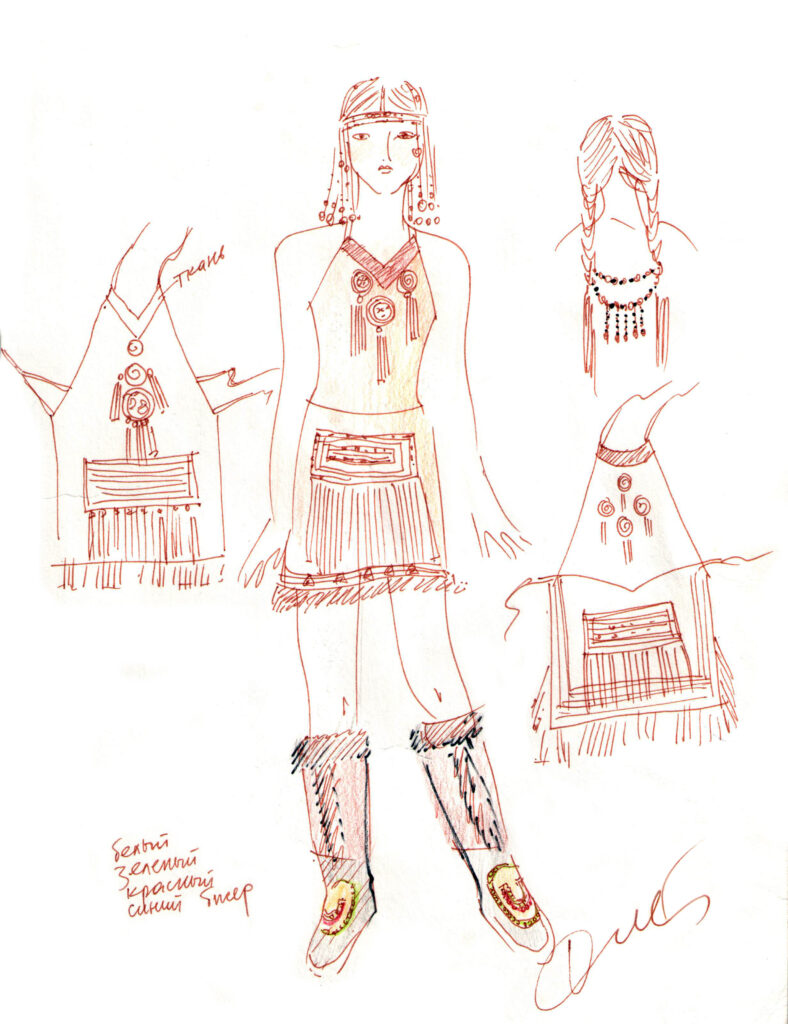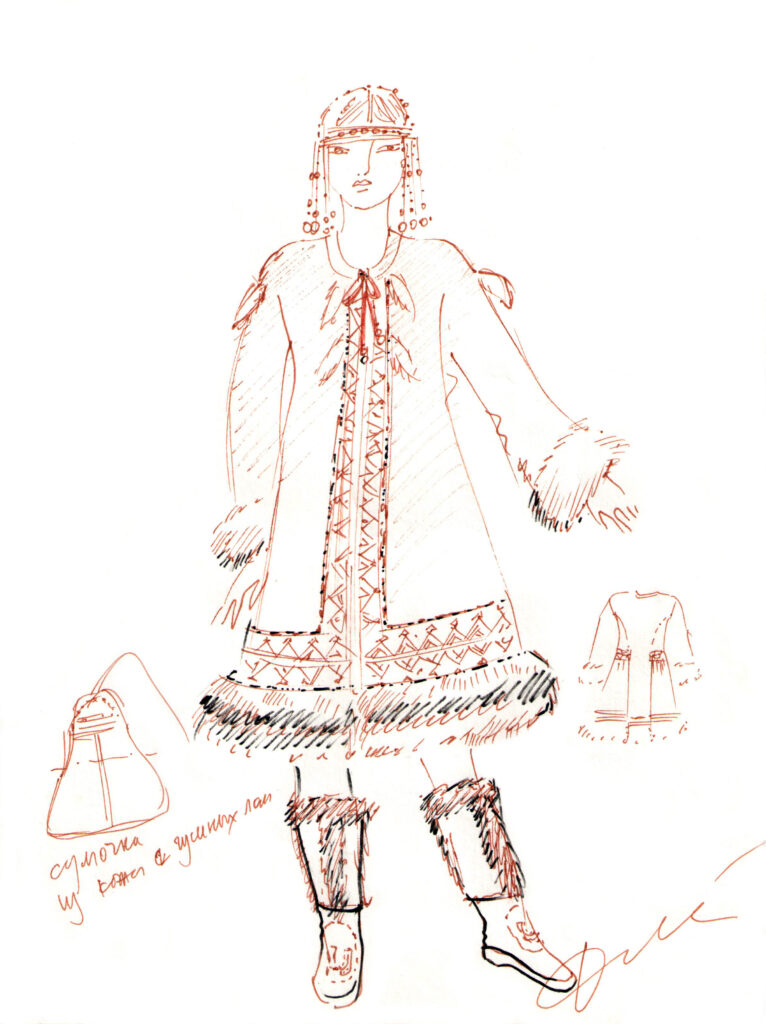Traditional Yukaghir costume and its stage embodiment on the example of the Yukaghir dance "Craftswomen"
Performer's costume is one of the important tools in creating an expressive stage image. The performances of national dances are especially difficult, when the stage director is faced with the task of transferring the traditional national costume to the stage.
The creator of a stage costume is obliged to research not only the material culture of the people whose dance is the goal of the production, but also to experience, to know the nature of the future image. This is especially important when staging dances of endangered cultures. It is necessary to create a costume based on the forms that existed at a certain historical time, so that the performers do not have to "replay" the costume, everything must be done with great tact, neat and restrained.
Материалы и методы. Любая сценическая постановка носит в себе значительный материал для познания культуры народа. Через исследование традиционного костюма юкагиров, в исследовании была поставлена задача изучения культурного наследия, быта и культуры малоизвестного народа юкагиров. Была изучена литература о культуре юкагиров, юкагирские костюмы в музеях г. Якутска и Департаменте по делам народов и федеративным отношениям РС (Я). Известно, что юкагиры (самоназвание – одул, вадул, алаи) – один из древнейших коренных народов Восточной Сибири. Это малочисленный коренной народ, по переписи населения в 2010 году в Республике Саха (Якутия) проживало 1.597 юкагиров. В юкагирской культуре, одежде, орнаментальном искусстве и предметах быта обнаруживается множество элементов, общих для культур соседних народов – эвенов, якутов, чукчей и коряков.
The tasks of determining the characteristic features of Yukaghir clothing, identifying symbolic and ornamental signs were set in the study. All this was necessary to create stage Yukaghir costumes. The culture of the Yukaghirs and the peoples of the extreme north-east of Russia was studied by V.I. Yochelson, L.N. Zhukova, A.A. Burykina, I.V. Konstantinova, G.N. and N.N. Kurilovs, V. I. Shadrina. In the works of these researchers devoted to material culture, traditional Yukaghir clothing is considered as an original element of culture, a synthesis of various types of decorative creativity, which brought traditional elements of cut, ornament, use of materials, ornaments and color symbols until the middle of the 20th century.
The Yukaghir clothing consists of a headdress, a swinging caftan, an apron, mittens, pants and shoes. Yukaghir clothing did not have gender differences: men's and women's clothing did not differ much from each other. They sewed clothes from deer, hare and bear skins. Clothing has a pronounced seasonal character; it distinguishes between summer and winter clothing.
Среди всех элементов создания одежды – кроя, материала и орнаментов, наиболее устойчивы к изменениям, как считает to L.N Zhukova, decorations and ornaments as elements of traditional culture.
 Yukaghir traditional culture is distinguished by color symbolism. The Yukaghirs are known to have a particular fondness for the red color obtained from a decoction of red alder. For the Yukaghirs, red had the sacred meaning of the base of the Earth, the Sun and the hearth. Also used dark colors, brown, black, dark brown. The Yukaghirs are very fond of bright light shades of the same red. This can be seen in many traditional costumes. Another feature of the Yukaghir costume is that the solar cult is very pronounced in the Yukaghir symbolism. The sun is the main pattern in the Yukaghir ornament. It is observed in the form of pendants, rings, mono- and polychrome beaded rosettes of yeloodjo - "the sun". For a long time, the Yukaghirs decorated caftans, aprons, hats, shoes, gloves, and handbags with these decorative elements. The “sun” rosette is simultaneously perceived by the Yukaghirs as an “eye” and had the meaning of protection from evil spirits and diseases.
Yukaghir traditional culture is distinguished by color symbolism. The Yukaghirs are known to have a particular fondness for the red color obtained from a decoction of red alder. For the Yukaghirs, red had the sacred meaning of the base of the Earth, the Sun and the hearth. Also used dark colors, brown, black, dark brown. The Yukaghirs are very fond of bright light shades of the same red. This can be seen in many traditional costumes. Another feature of the Yukaghir costume is that the solar cult is very pronounced in the Yukaghir symbolism. The sun is the main pattern in the Yukaghir ornament. It is observed in the form of pendants, rings, mono- and polychrome beaded rosettes of yeloodjo - "the sun". For a long time, the Yukaghirs decorated caftans, aprons, hats, shoes, gloves, and handbags with these decorative elements. The “sun” rosette is simultaneously perceived by the Yukaghirs as an “eye” and had the meaning of protection from evil spirits and diseases.
In other ornaments, patterns and finishing techniques, there is a significant similarity with the elements of the material culture of other peoples. Taking these features into account in my practical work, I created a stage costume for craftswomen and a man's costume for the future performance of "Dance of the Reindeer Herders". These basic colors of the traditional costume were taken into account in the creation of the stage costume.
When preparing stage costumes, the goal was to preserve the color of the traditional Yukaghir costume. The Yukaghir aprons (male and female), footwear (torbaza) with stripes ornaments were reproduced. In addition to the cut and ornaments, the main task when creating a costume is the material, which becomes the main difference in the costumes of the peoples of the north-east of Russia.
For the performers’ costumes, we used artificial leather, suede and fur. This was necessary to make the performers more comfortable and easier to move. The costume was complemented by shoes made of deerskin. To decorate the stage costume, a bastian headdress made of colored beads was added. This made the stage costume more expressive and bright.
Танец «Мастерицы» отражает возвращение мужчин племен после долгой зимней охоты с добычей, когда женщины – мастерицы могли шить из добытых шкур украшения и одежду. Для создания сценического костюма танцевального номера «Мастерицы» необходимо было знать, как правильно использовать материал с учетом покроя и украшений. В процессе создания костюма было взято за основу украшение зимнего женского передника из оленьей шкуры и торбаза (обувь). Известно, что перенесение основных орнаментов, украшений, одежды традиционного костюма в сценический костюм всегда сложно. Можно использовать такие материалы как габардин, искусственные кожу, замшу и мех, шкуру оленя для обуви.
Таким образом, задача постановщика, как исследователя – с одной стороны, восстановить традиционный костюм юкагиров с его символами, национальной атрибутикой, создать такой вариант костюма, в котором был бы сохранен его национальный колорит. С другой стороны, перенести костюм на сцену таким образом, чтобы благодаря упрощенному варианту одежды танцорам удалось передать пластику юкагирского танца, наиболее его характерные движения. Результаты и обсуждение. В исследовании были поставлены задачи определения характерных особенностей одежды юкагиров, выявления символических и орнаментальных знаков. Все это было необходимо для создания сценических юкагирских костюмов. И показало, что действительно такой подход дает хорошие результаты. Созданные на основе исследования традиционной юкагирской одежды сценические костюмы для постановки «Мастерицы», получили положительные отзывы директора Государственного театра коренных малочисленных народов РС(Я) Nikitina A.L. and Dmitrieva D.P., costume designer of the Sakha Academic Theater named after P.A. Oyunsky.
The study revealed the features in the cut, material and ornament of Yukaghir clothing, in the technology of dyeing suede in shades of red, various variations in the use of solar signs in ornament and in the form of jewelry. The conclusions of the research, the revealed features were taken into account and reproduced in the stage costume of the production of "Craftswomen" became the basis for the preparation of other Yukaghir stage costumes. The significance of such a research approach in the preparation of costumes for dance performances is that a stage costume is not only an external expression of an image in a production, but also a way to maintain and preserve the unique cultures of the indigenous peoples of Siberia.
Список литературы:
1. Бурыкин А. А. Проблемы семантики орнамента и элементов традиционного костюма: вопросы этносемиозиса на фоне этнокультурных и языковых связей по материалам декоративного искусства народов крайнего северо-востока // Диалоги во времени: традиционное искусство в контексте музея. Вып. 2. Спб: МАЭ РАН, 1998
2. Бурыкин А. А. Этнография, фольклор и язык малочисленных народов Севера в контексте современной культуры (обзор) // История ментальности: традиционная культура в контексте музея / А. Бурыкин. Спб: МАЭ РАН, 1998
3. Жукова, Л.Н. Одежда юкагиров. Учеб. пособие. Якутск, Якутский край, 1996 – 143 с
4. Жукова, Л.Н. Очерки по юкагирской культуре. Новосибирск, Наука, 2009. – 152 с
5. Иохельсон, В.И. Юкагиры и юкагиризированные тунгусы / В.И. Иохельсон; Новосибирск: Наука, 2005. – 675 с
6. Курилов Г.Н. Избранное [Текст] : стихотворения, поэмы, рассказы, эссе, публицистика / Улуро Адо. – Якутск : Бичик, 2013. – 351 с
7. Юкагиры. URL: (https://ru.wikipedia.org/wiki/ (дата обращения: 10. 05.2016)

